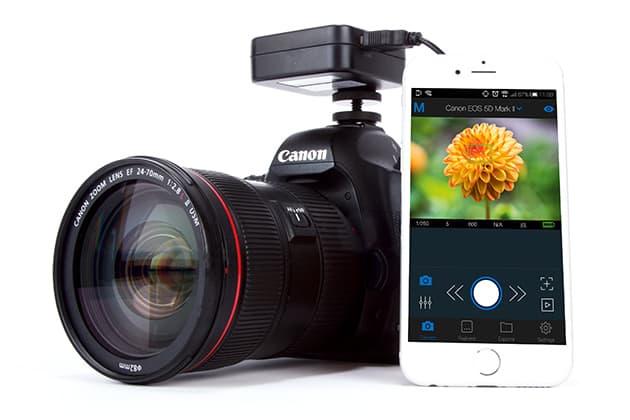Case Remote Wireless DSLR Controller at a glance:
- Brings remote shooting to cameras without Wi-Fi
- App available for Android, iOS and Windows PC
- Allows automated timelapse, focus stacking, bracketing and HDR
- Can be used to shoot both stills and video
- Price £119.99
- Website: www.caseremote.com
The Case Remote Wireless DSLR Controller allows photographers to control their DSLR remotely via a smartphone, tablet or PC, even if their DSLR doesn’t come with a built-in Wi-Fi module. Many new cameras, especially high-end models such as the Nikon D810 and the Canon EOS 5DS/5DS R, still don’t have any Wi-Fi functionality. While the Canon EOS 5DS is still relatively new for the Case Remote to support, the D810 is one of many cameras included in the list of compatible models. A full list of cameras can be found at www.caseremote.com.
The unit works by creating its own Wi-Fi hotspot that other devices can then connect to. Once connected, and the Android/iOS/Windows PC app is launched, you can take control of the camera’s settings and access live view on most models, then capture photos or video. For our test, we used an iPhone 6 and an HTC One M9, and the app seemed to function similarly on both smartphones.
Settings that can be adjusted from within the app include ISO sensitivity, shutter speed, aperture, white balance, drive mode and metering mode. With this functionality, users can control almost every feature of their camera remotely. This means the camera can be moved to locations that would be tricky to work in, and then take pictures, change settings and shoot video without having to touch it. This is particularly useful when shooting from high or low vantage points, or potentially dangerous locations, as users can get out of the way and not have to worry about where the camera is. The Case Remote is also quite handy when shooting landscapes on a tripod, as it can act as a wireless cable release.
Features tab

Using the bracketing mode I took five separate photos, from -2 to +2EV varying the shutter speed, which allowed me to create a tonally rich HDR image
The most impressive feature of the Case Remote is the advanced features options. The app has a menu, towards the bottom of the screen, where a variety of options can be found, including bracketing, bulb, continuous, focus stacking, HDR and timelapse mode.
The bracketing mode allows you to bracket ISO sensitivity and change the exposure compensation up to ±5EV in 1EV increments. Bulb mode allows users to tap the shutter button in the app, preview how long the shutter is open for on-screen and tap it again to end the exposure. Continuous allows users to ‘press’ the shutter button in burst mode by tapping the button on the app to shoot a series of images.
The focus-stacking feature is perhaps the most interesting. It enables you to select how many photos you wish to stack, up to a maximum of nine, and with the option to shift the focus motor in small, medium or large increments either forwards or backwards. All this is carried out automatically, but it can also be shifted by minor amounts manually. I didn’t know it was possible to carry out this action with a piece of software until I tried the Case Remote.
Although the unit is limited to taking a maximum of nine images at any one time, once finished, users can shoot a further nine images from where they left off, using focus shift. This makes the Case Remote’s focus-stacking feature useful for macro and landscape photography, which usually requires upwards of ten different images in order to create a detailed focus-stacked shot.
The HDR feature is also very interesting. It allows you to bracket ISO, shutter speed or aperture to create 1-9 images in 1, 2 or 3EV increments. This allows users to take their images into post-production software and create detailed HDR photos from bracketed shots.
Timelapse enables a start time and an end time to be set, and at what time interval images should be taken. It then shows exactly how many frames will be taken throughout the duration. This makes it very easy to calculate how many frames are needed and how long the final footage will be compared to other methods of capturing timelapse footage.
When capturing images, you can preview the shot as a thumbnail and tap a button to download it. Even images that are already on the card can be downloaded, so the Case Remote is effectively a wireless card reader, too.

Focus stacking mode moves the AF motor a small amount with each picture. This image is with focus stacking.
Case Remote Wireless DSLR Controller – Our verdict
Wireless camera controllers are prone to time lag, but I found the Case Remote to have very little delay and it refreshed reasonably quickly. Like many similar devices, the app can crash at times, but not that frequently. Being able to perform small adjustments to the focus remotely is great, but I was unable to enlarge the image to check the focus – something that is featured on many Wi-Fi apps and on some of the Case Remote’s competitors.
However, as a company, Case Remote is very proactive, tending to fix software bugs quickly, and developing new apps and adding extra functionality to existing products, so I wouldn’t be surprised if focus enlargement is added very soon.
The trouble is that, right now, the Case Remote is not the complete package. On several occasions, the unit didn’t work how I wanted it to, and a few things have been overlooked. For example, when I updated to firmware v2.2 using my Canon EOS 5D Mark II, the focus no longer shifted when using ±1 settings for focus stacking. Instead, it only worked in 2 or 3 settings, making minor focus shifting impossible. Also, when you start focus stacking, if you notice something is wrong, you can’t back out once the shutter is pressed. That could mean being committed to nine 30-second exposures with a 10-second shutter delay unless you reset the camera or Case Remote.
The feature set is extensive, though, and I particularly like the HDR, timelapse and bulb shooting settings. If your DSLR doesn’t have Wi-Fi, and you would benefit from wireless control of your camera, the Case Remote is a worthwhile buy. While it’s not without its faults, it is less expensive than many of its main competitors and it offers a lot of features for the money.









